Top 15 Biggest Sharks in the World
If you suffer from galeophobia, the fear of sharks, then you’re going to want to go do something else. This educational experience is definitely not for you. And why is that? Well, we’re about to focus on some pretty huge sea creatures.
From a 20-foot Great White Shark to “Slash,” the shark with a bad attitude, here are 15 of the biggest sharks in the world ever recorded.
Top 15 Biggest Sharks in the World 2025
#15: Hammerhead Shark (Fort Lauderdale, Florida)
- Size: 13 feet
- Weight: Approx. 500-1,000 pounds
- Country: USA
- Notable: Rarely found so close to beaches.
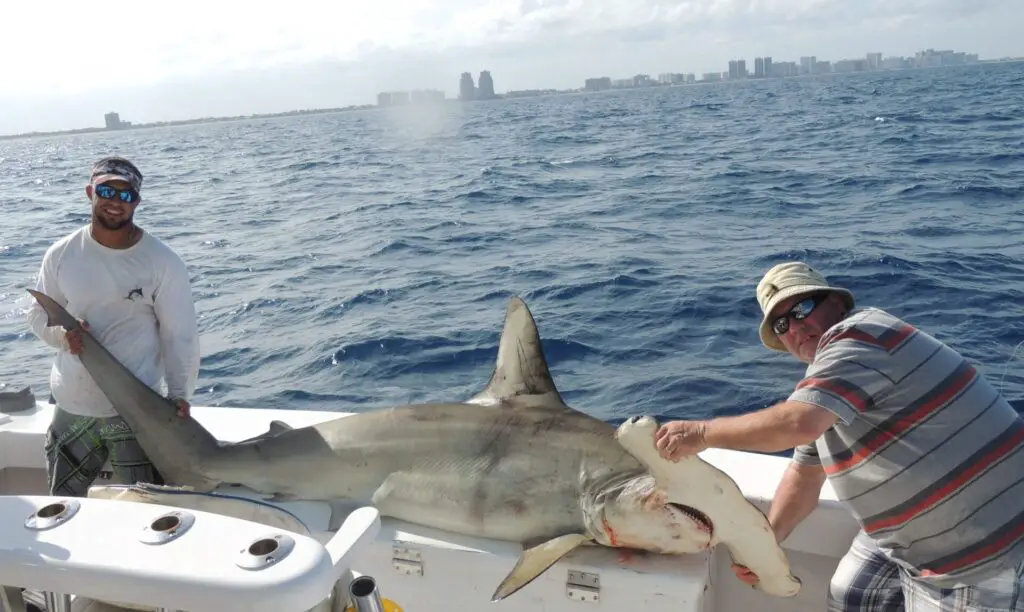
When you go fishing on a pier, you might expect to catch a small fish or two to feed your family for dinner. What you don’t expect is for a 13-foot hammerhead shark to launch itself onto your fishing pole. A family was having a lovely day at the beach in Fort Lauderdale, Florida, when they watched two people with a fishing pole struggle with what seemed like a giant fish off the pier. But it was not a large fish; it was an enormous shark.
What’s unique about this situation is that the shark was hooked from a pier hundreds of feet from the beach. Rarely do large hammerheads explore shallow areas of a beach. An angler, Ryan Bolash, who is the creator of the YouTube channel Infinity Fishing Team, acted quickly to cut the wire dangling from the hook in the shark’s mouth.
By doing so, they gave the shark a chance of survival, which was essential given that hammerhead shark numbers are in decline. Ryan said the best thing to do is to bring them out of the water and back into it in under 2 minutes, which he said takes a lot of experience. Do you know about the biggest dog in the world?
#14: Great White Shark (“Deep Blue”)
- Size: 20+ feet
- Weight: 2.5 tons
- Country: Hawaii, USA
- Notable: One of the largest Great Whites recorded, spotted near Oahu.

Seeing a great white shark of any size can put the fear of God in you. After all, you only need to watch the movie Jaws to know what they are capable of. Still, there’s something quite exciting about being able to say you’ve seen the largest ever recorded great white shark in person. That is exactly what some divers got to say.
People diving near Oahu, a Hawaiian island, were able to capture photographs of the great white shark that has the nickname of “Deep Blue.” The 2.5-ton shark is thought to be around 50 years old. It was tagged by scientists more than 20 years ago after it was spotted off the coast of Mexico. The divers, Mark Mohler and Kimberly Jeffries, had seen Deep Blue eating a dead sperm whale and were able to swim alongside it while it ate.
We’re not sure if that’s brave or a bit stupid, really. They were also able to capture video of it feasting on the whale, which happened after tiger sharks made the initial whale discovery. As you can imagine, they made a quick departure after spotting the giant great white shark.
#13: Tiger Shark (Seven Mile Beach, Australia)
- Size: 19.68 feet
- Weight: Approx. 1,900-2,000 pounds
- Country: Australia
- Notable: One of the most aggressive shark species.
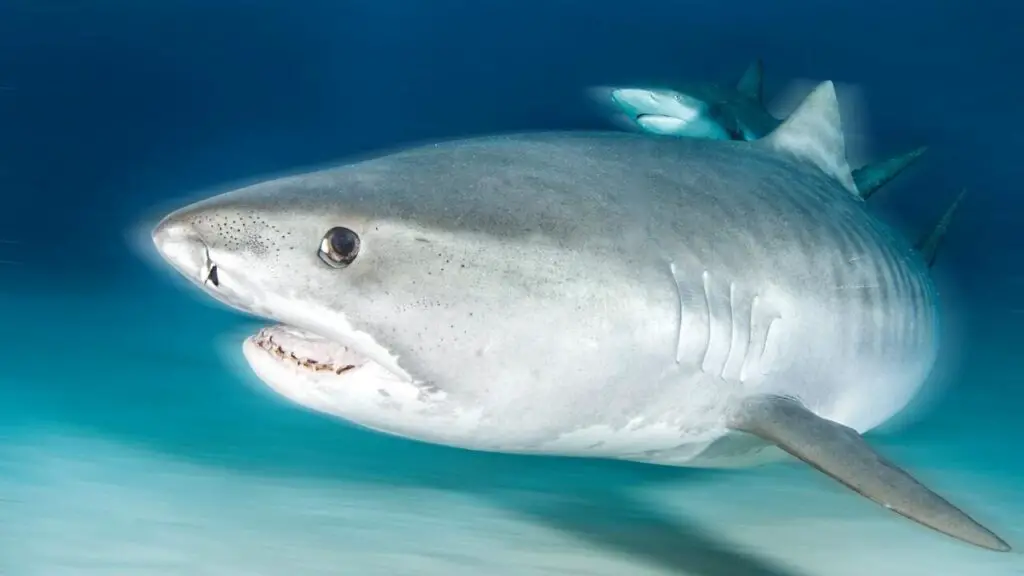
Tiger sharks may not be the largest sharks in the world, but they are certainly some of the most aggressive. They’re responsible for an alarming number of attacks, only coming second to the great white shark. So you probably don’t have a lot of sympathy for the 19.68-foot tiger shark caught off Seven Mile Beach near Lennox Head on the New South Wales northern coast of Australia.
Fishermen caught the shark by boat, and Jeff Brooks posted images of it online. According to Jeff, the shark was purposefully caught under a kill order. Apparently, it had been responsible for a local attack. Most tiger sharks grow up to 13 feet long and 1,400 pounds; larger females can even weigh up to 2,000 pounds. There have also been cases of people hauling in 24-foot tiger sharks, but very few exceed 20 feet.
Perhaps what makes tiger sharks more prone to human attacks than other sharks is that they aren’t fussy. They have the widest food spectrum of all sharks. They dine on fish, seals, crustaceans, dolphins, squid, and even birds. However, due to fishing by humans and finning, they are a nearly threatened species.
#12: Mako Shark (Huntington Beach, California)
- Size: Over 10 feet
- Weight: 1,323 pounds
- Country: USA
- Notable: Possibly a new angling record for size.
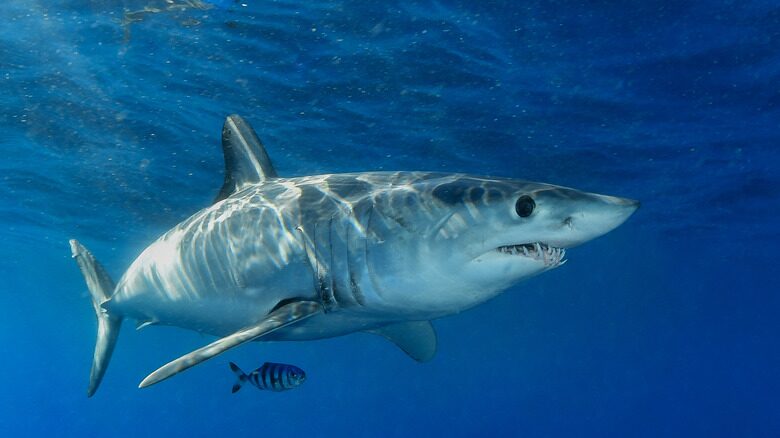
It seems that the winning recipe for hauling in that giant catch is chopped mackerel and ground chum—or so four fishermen say who caught a 1,323-pound mako shark off the coast of Huntington Beach in 2013. Deep Blue is a very large, big female shark. The fishing boat’s captain, Matt Potter, owns a store called Mako Matt’s Marine, and he and his friends go sport shark fishing many times throughout the year. They were on the final day of a three-day trip when they spotted the fins of what looked like a mako shark.
Then the struggle ensued. The fishermen spent around two and a half hours bringing in the massive shark on giant hooks. One of the fishermen, Jason Johnston, harnessed himself to the boat and shark, and Frankie Milinazo tied the shark to the side of the boat. S
cripps Institution of Oceanography fisheries research biologist Nick Wegner said the shark would likely set a new angling record. He had heard of 1,400 to 1,500-pound mako sharks being harpooned, but not any in this way so close to shore. The men took the shark to a processing plant to weigh it and put it in the freezer; it would be used for research.
#11: Great White Shark (Nova Scotia, Canada)
- Size: 15.4 feet
- Weight: Approx. 2,000 pounds
- Country: Canada
- Notable: Covered in scars from battles, one of the largest seen off Nova Scotia.
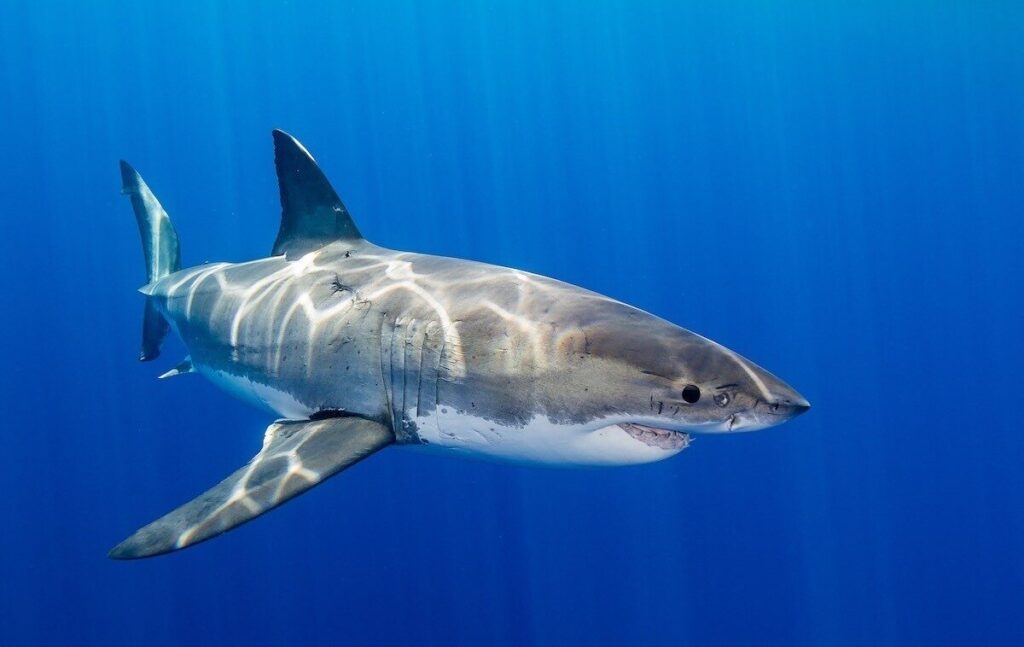
Two huge great white sharks were discovered by American researchers off the coast of Nova Scotia in late 2019. The first was a 13-foot great white, which appeared to have been savagely attacked by something even larger. The shark, which they named “Vimy,” had clearly been in a scuffle of some sort. U.S.-based OCEARCH (O-C-E-A-R-C-H) founding chairman Chris Fisher said the shark was covered in scars with a fresh wound along its head. He said that while the shark was the biggest they had caught, it was clear it was not the biggest out there. They believe what bit Vimy would have been at least 13 feet. Chris believes another male shark fighting for a mate may be to blame, or it could be a larger female who didn’t want to mate alongside Vimy.
Researchers also caught a 15.4-foot shark, which they called “Unomaki.” This shark was also up there in size; she was the second largest they had ever caught, only beaten by “Mary Lee,” a shark they had found in Cape Cod. Unomaki appeared to be in far better shape than Vimy, that’s for sure.
Top 10 Biggest Sharks in the World
#10: Great White Shark (Sea of Cortez, Mexico)
- Size: 20 feet
- Weight: 2,000 pounds
- Country: Mexico
- Notable: Caught accidentally in a fishing net, fortunately dead.
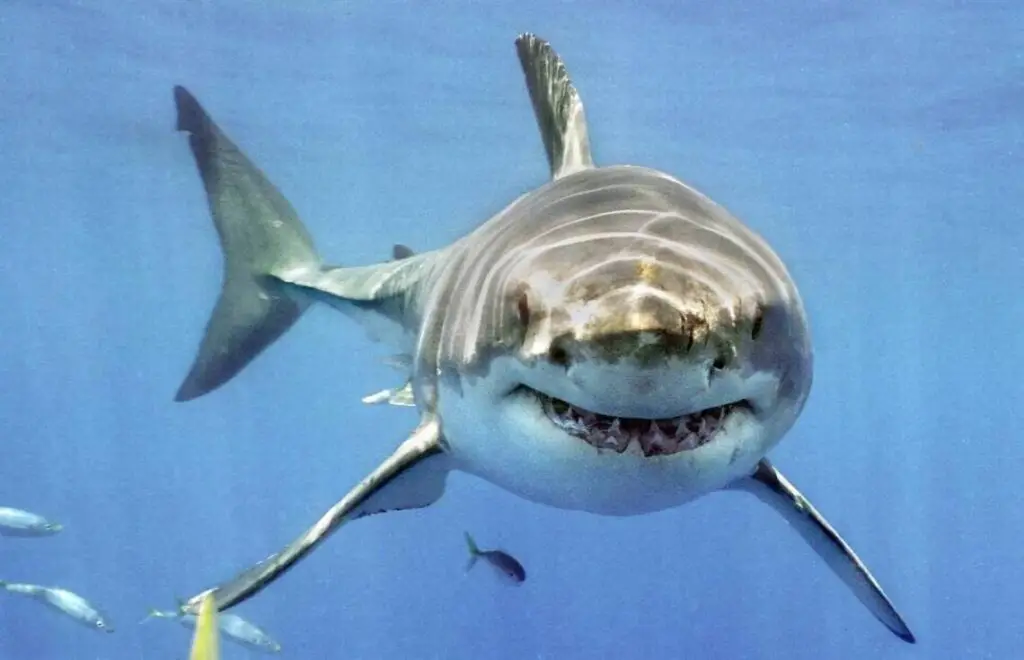
There’s only one word to describe a great white shark, and to us, it’s terrifying. They are large mackerel sharks found in coastal waters in most oceans. They often grow up to 20 feet long and can even weigh up to 5,000 pounds—that’s about a third as heavy as a T-Rex. These sharks can live for around 70 years, making them the longest-living cartilaginous fish. However, they take 26 years to reach maturity, and females are 33 before they’re ready to produce young. But young or old, they are scary to see in person, especially if you come across them accidentally.
Two fishermen in Mexico learned this firsthand when they accidentally caught a 2,000-pound, 20-foot great white in their fishing net. They were fishing in the Sea of Cortez off Sonora State when they made their discovery. Fortunately for them, the shark was dead; otherwise, it would likely have overpowered them and their boat, and who knows what would have happened next. They aren’t likely to forget this fishing experience in a hurry, that’s for sure.
#9: Great White Shark (Prince Edward Island, Canada)
- Size: 17 feet
- Weight: Approx. 2,000 pounds
- Country: Canada
- Notable: Named one of Discovery Channel’s top 5 legendary sharks.
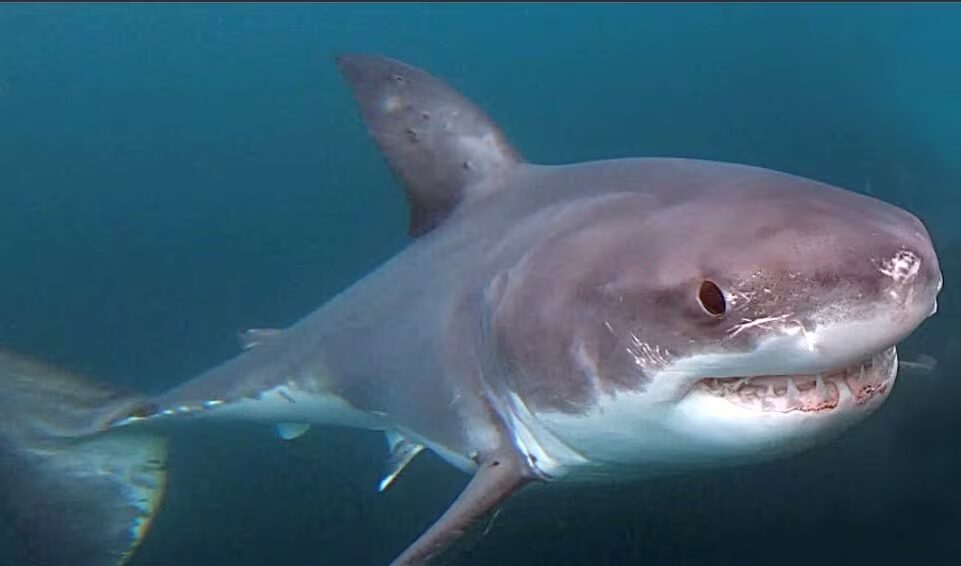
In 1983, Albertan fisherman David McKendrick was fishing off Prince Edward Island when he made a shocking discovery. He had just caught a 17-foot great white shark in his net. By the time he pulled it to the surface, he realized the gigantic creature was dead. Roll the clock forward three decades, and you may be wondering why this shark is still being talked about. Well, according to Warren Joyce from the Canadian Shark Research Laboratory in Bedford, it’s one of two of the largest measured sharks in the world. The female shark was a mere teenager of 19 years old when it was caught, which meant its size was phenomenal. As a result, it has been named one of the Discovery Channel’s top 5 legendary sharks.
Not only was the size of this shark surprising, but the location in which it was found was too. There are usually only reports in the area of great white sharks every two to three years. In 130 years, there have been only a few dozen recorded instances of great whites in the area.
#8: Cojímar Monster (Cuba)
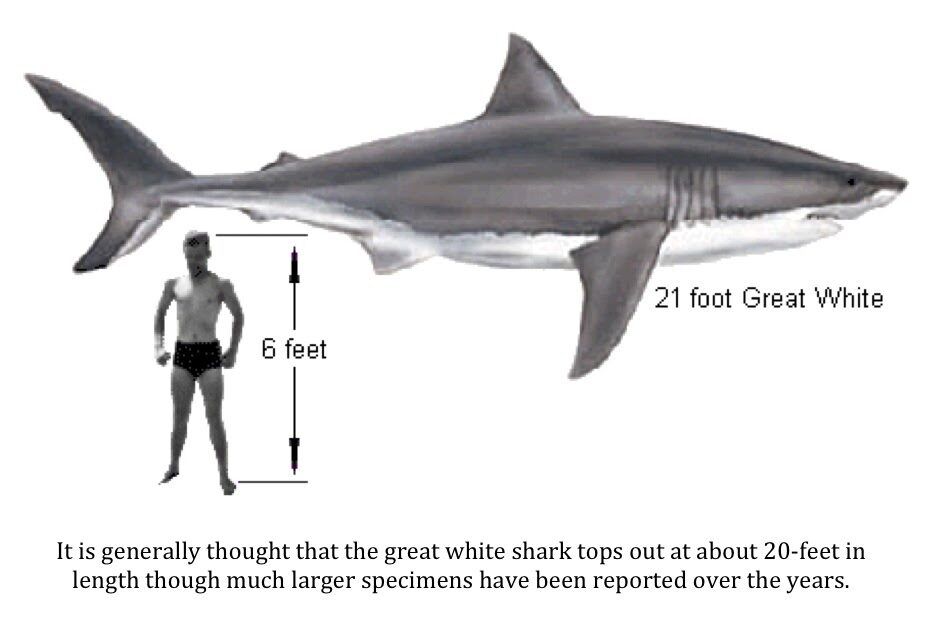
- Size: 21 feet
- Weight: 7,100 pounds
- Country: Cuba
- Notable: Responsible for taking entire fishing rigs.
In 1945, fishermen around Cojímar were convinced that something massive was lurking in the waters around the north coast of Cuba. In fact, they were sure it was a giant sea monster. They had been noticing that their entire floating fishing rigs were going missing, which was not only expensive but frustrating. That wasn’t all, either—sometimes they were only pulling in hooked heads, with the entire bodies of their catches missing. And those same fish, if they had been intact, would weigh over 500 pounds. So what was taking their fish?
José Hernández and Juan Yuca, two fishermen, noticed a huge shadow in the water around them and a massive wake that was following their line. It was like a suspenseful scene in a horror movie. It was then that they decided they had to catch this monster, and it caused enough frustration. As it turns out, the sea monster that had been stealing all the fish was a great white shark, the swaggering bully of the deep.
This one, in particular, was bigger than most. When they eventually managed to catch the shark, it weighed 7,100 pounds and measured over 21 feet long. Given that fishing boats of the 1940s were only around 18 feet long, or a few select cruisers up to 38 feet, the shark would prove to be a huge menace and danger if left, so they had to take care of the problem.
#7: Slash” the Shark (Stewart Island, New Zealand)
- Size: 16.4 feet
- Weight: Approx. 2,000 pounds
- Country: New Zealand
- Notable: Known for its bad attitude and large scar.
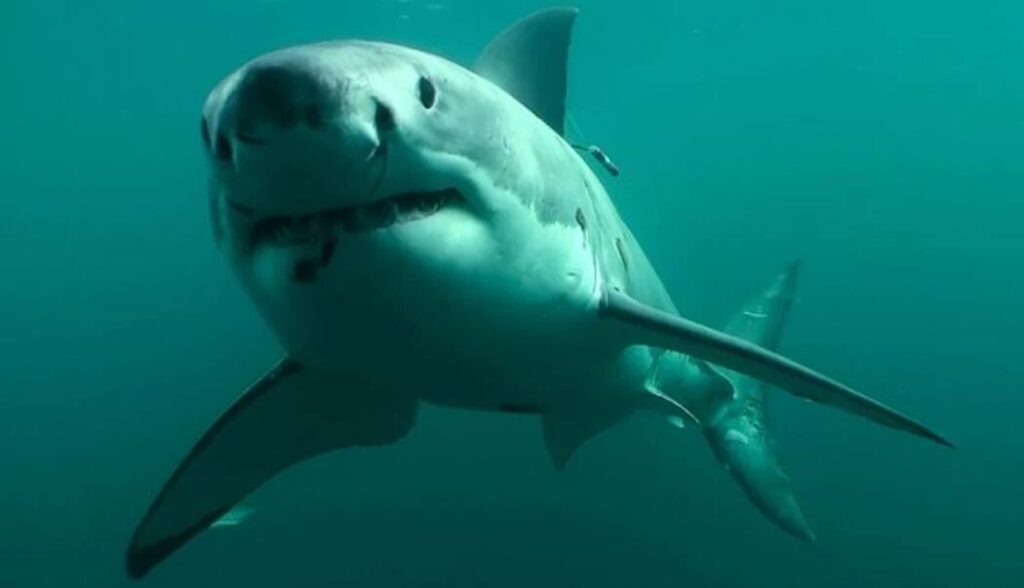
In 2013, a special shark called “Slash” was the poster boy for Discovery Channel’s Shark Week, which well and truly put New Zealand on the map. Slash is a 16.4-foot great white shark with a bad attitude and a giant gash around his mouth. According to the Shark Week documentary creators, he is a local legend. The huge shark didn’t get his name by accident, either. The Department of Conservation and NIWA (National Institute of Water and Atmospheric Research) had attempted to tag the shark to track its movements. Needless to say, the task was botched, and Slash now bears the scars; eventually, these will heal.
Believe it or not, Stewart Island in New Zealand has some of the largest and most aggressive great whites on the planet. Along with Fiordland and the Chathams, hundreds of them migrate to the area during the summer, then head towards the tropics for winter. Surprisingly, given the large population of sharks in the area, the country sees very few attacks. There have been two fatalities in the past two decades and 115 recorded attacks since the 1800s.
#6: Great White Shark (Queensland, Australia)
- Size: 20 feet 8 inches
- Weight: Approx. 2,200 pounds
- Country: Australia
- Notable: Captured by famous shark hunter Vic Hislop.
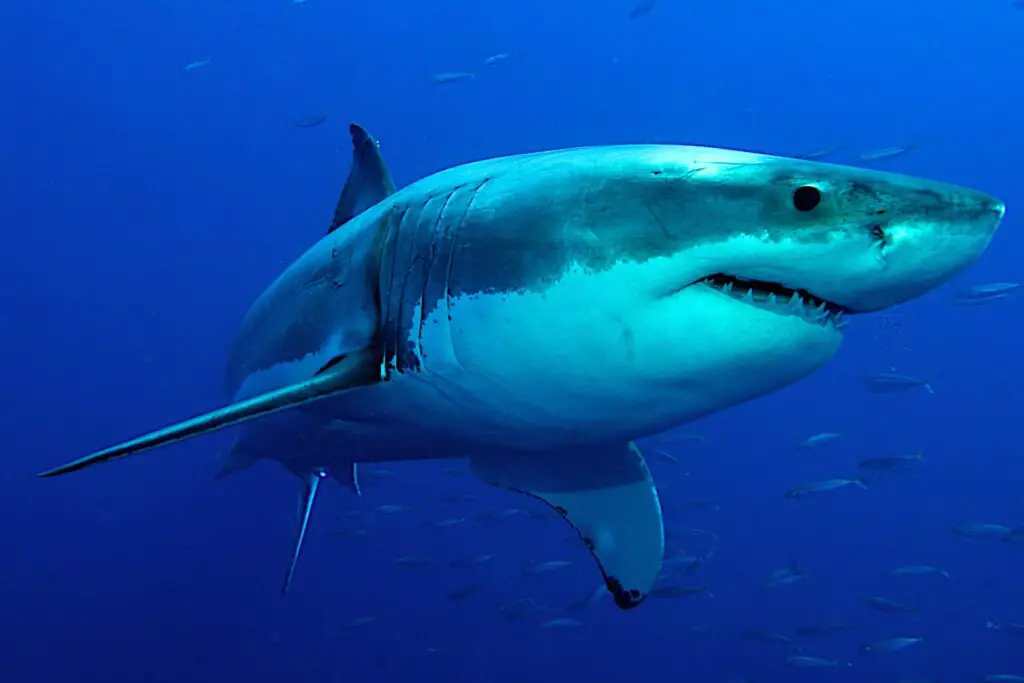
One of the biggest sharks in the world ever recorded was a 20-foot, 8-inch great white shark captured by Vic Hislop in 1987. If you’re a shark enthusiast and the name Vic Hislop sounds familiar, then there’s a reason for that. Vic, who hails from Stanthorpe, Queensland, in Australia, was a shark hunter. The world understands that sharks are an essential part of the ocean’s ecology, but Vic had other ideas. He said that sharks were “God’s mistake” and that it was his mission to kill them and correct that mistake.
Vic has also claimed that the Australian government has covered up fatal shark attacks by recording them as drownings. He believes that it did so to protect the country’s tourism. Vic said, “At least a hundred swimmers disappear every year, and their bodies are never found. Many have been eaten. I’ve often caught sharks and removed human hands and feet from their stomachs. I even found a human foot still in its sandal.” While he supports the protection of whale sharks, sand tiger sharks, and other harmless species, he’s definitely not that forgiving with the likes of great whites.
#5: Great White Shark (Kangaroo Island, Australia)
- Size: 23 feet (disputed)
- Weight: Approx. 2,400 pounds
- Country: Australia
- Notable: Considered one of the largest by experts.
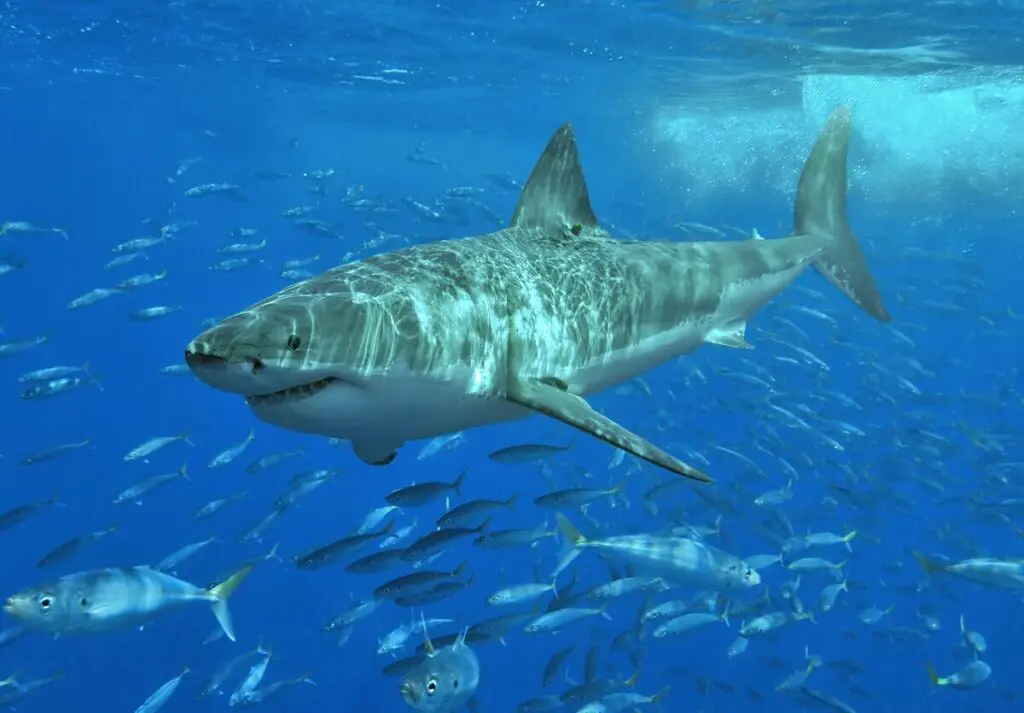
In 1987, shark lovers in Australia were blown away to discover that one of the largest sharks in the world ever recorded was on their own shores. A great white shark was captured near Australia’s Kangaroo Island, and it was thought to be at least 23 feet long. That said, there have been a lot of arguments around this measurement since that day. A shark expert by the name of J.E. Randall suggested that the shark was between 19 and 21 feet long, but I.K. Ferguson said it was between 17 and 19 feet long. So what was it?
A team of scientists decided to get to the bottom of it. They reviewed the case information relating to the find and conducted a morphometric analysis of the shark remains and photographic evidence. Their goal was to validate the original measurements. What they found was reasonably consistent with that first record. In all likelihood, the Kangaroo Island great white shark really was 23 feet long, which wouldn’t be surprising. It’s a well-known fact that great white sharks live around Australia and New Zealand. They will seek out warmer waters, depending on what time of year it is.
#4: Great White Shark (Malta)
- Size: 23.7 feet (disputed)
- Weight: 6,349 pounds (disputed)
- Country: Malta
- Notable: Still debated among experts about its true size.

Shark experts always find themselves in arguments. The ocean has so many mysteries that it can be hard to prove or disprove anyone’s theories. But when it comes to a task that’s as easy as measuring something, it shouldn’t be that hard, should it? Apparently, it is because a shark caught in Malta is still being argued about decades later.
In 1987, Alfredo Kudahar captured a great white shark off the coast of Filfla in Malta. He measured it at 23.7 feet long and with a weight of 6,349 pounds. When he and John Abella were interviewed about their shark in the mid-1990s for a documentary called Jaws in the Mediterranean, their story changed. All of a sudden, the shark was 23 feet long. John confirmed that too. They said they had laid the shark on the floor and measured it twice, and that it was 23 feet in length. But according to Isabelle Mate and Joan Borrell,
the actual length of the shark was 20 feet and weighed 4,400 pounds. This pair researched great white sharks for 20 years and concluded that the Maltese shark was a mere 20 feet. But without evidence, such as photos and other material, it can be hard to prove anything.
#3: Great White Shark (Ledge Point, Australia)
- Size: 19.7 feet
- Weight: Approx. 2,000 pounds
- Country: Australia
- Notable: Found near the site of a previous shark attack.
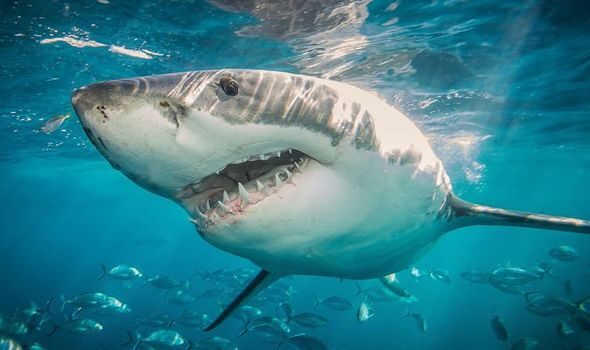
Sharks are measured in length, not weight, which is why so many shark hunters focus on getting the measurements right. When it came to a shark caught by Frank Mundus, he was able to put an accurate figure on the weight but wasn’t as sure about its length.
Frank was well known for being one of the best shark hunters in Montauk, New York. He even inspired the character Captain Quint in the movie Jaws. In August 1986, he had a surprise encounter with a shark he didn’t think existed. He spotted a great white shark, captured it, and it was estimated to weigh over 5,000 pounds. This made it one of the largest fish ever caught by rod and reel. But Frank wasn’t able to get a completely accurate length. He estimated it to be around 28 feet long, but he didn’t have the equipment to measure it, so that was only a guess.
We will probably never know how accurate he was. However, we can still appreciate how massive this shark was. For comparison, the world’s biggest captured shark is thought to have been a whale shark. A whale shark captured in Pakistan in 1947 was measured at 41.5 feet long.
#2: Great White Shark (South Australia)
- Size: 23 feet
- Weight: Estimated over 2,400 pounds
- Country: Australia
- Notable: Largest shark ever seen by local patrol.
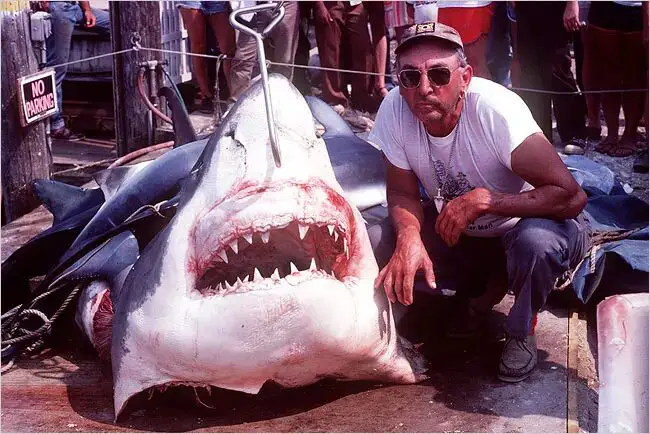
You can tell that Frank Mundus’ name was well-known in the shark community because of how often he appeared in headlines. But in 1986, he caught one of the largest fish he had ever seen. He captured a great white shark, estimated to weigh more than 5,000 pounds. The same fish was around 28 feet long, but that was only an estimate. No one was entirely sure just how big the fish was.
Frank’s incredible feat remains unmatched in the history of sportfishing. Many believe this massive great white was the basis for the legendary shark from the movie “Jaws,” as it served as an inspiration for the film’s fictional monster. Although Frank’s estimated length was never confirmed, his shark’s size and weight continue to be the stuff of legend.
#1: “Deep Blue” (Guadalupe Island, Mexico)
- Size: 20 feet
- Weight: 5,500 pounds
- Country: Mexico
- Notable: Largest Great White ever recorded, around 50 years old.
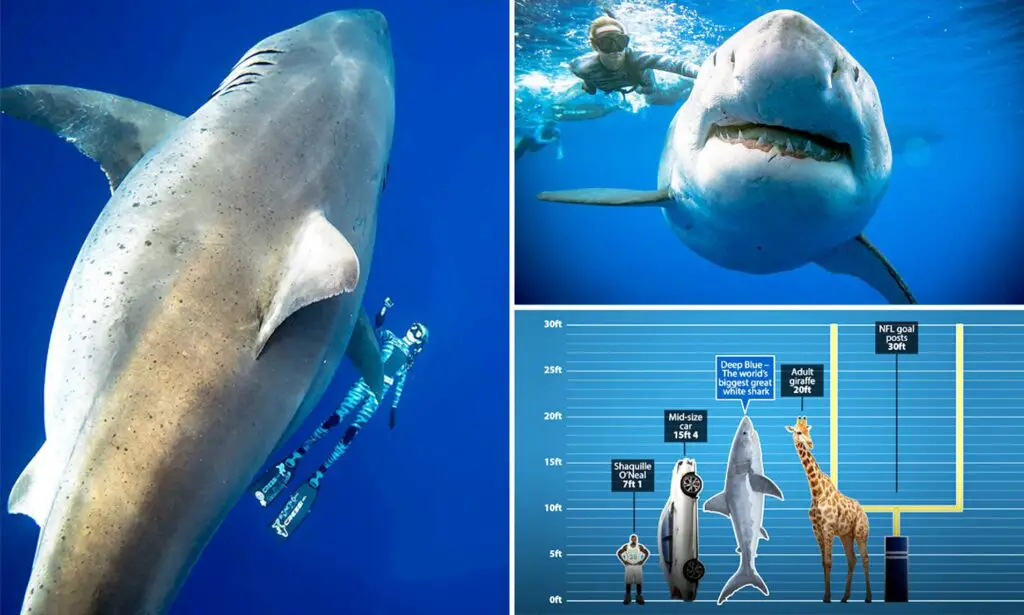
Deep Blue is the name of a female great white shark that has taken the title of the largest great white ever recorded. She measures in at 20 feet long and is estimated to weigh a whopping 5,500 pounds. She first gained attention when researchers spotted her near Guadalupe Island, Mexico, during filming for Discovery Channel’s Shark Week in 2014. The footage of her went viral, and she quickly became a sensation, with her massive size and calm demeanor fascinating shark enthusiasts and marine biologists alike.
Researchers believe Deep Blue is around 50 years old, making her one of the oldest known great whites. Her size and age suggest that she is likely one of the dominant predators in her environment. Her popularity has only grown over the years, with additional sightings and footage continuing to captivate audiences worldwide. Deep Blue’s fame serves as a reminder of the incredible power and mystery of the ocean’s top predators.
These enormous sharks not only showcase the remarkable size and strength of these apex predators but also highlight the importance of continued research and conservation efforts to protect these magnificent creatures and their habitats.
Please let me know if any adjustments are needed.
FAQ’s
Is a megalodon bigger than a whale shark?
Yes, the megalodon was much larger than a whale shark. The megalodon, which lived millions of years ago, is estimated to have reached lengths of up to 60 feet or more. In comparison, the largest whale sharks today typically grow to about 40 feet.
What is the largest shark alive right now?
The largest shark alive today is the whale shark. It can grow up to 40 feet long and weigh as much as 20 tons. Despite its massive size, the whale shark is a gentle giant that primarily feeds on plankton.
What is the largest shark ever caught on camera?
The largest shark ever caught on camera is a female great white shark known as “Deep Blue.” She measures about 20 feet in length and weighs an estimated 5,500 pounds. She was first filmed near Guadalupe Island, Mexico, and is one of the most famous sharks in the world.
What is the largest great white shark ever recorded?
The largest great white shark ever recorded is “Deep Blue,” a female shark measuring approximately 20 feet long and weighing around 5,500 pounds. She was first documented off the coast of Guadalupe Island, Mexico, and is considered the largest of her species ever observed.